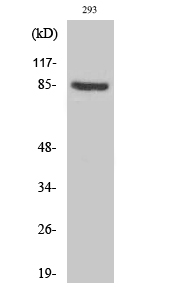PNPase Polyclonal Antibody
- Catalog No.:YT3807
- Applications:WB;IHC;IF;ELISA
- Reactivity:Human;Mouse
- Target:
- PNPase
- Fields:
- >>RNA degradation
- Gene Name:
- PNPT1
- Protein Name:
- Polyribonucleotide nucleotidyltransferase 1 mitochondrial
- Human Gene Id:
- 87178
- Human Swiss Prot No:
- Q8TCS8
- Mouse Gene Id:
- 71701
- Mouse Swiss Prot No:
- Q8K1R3
- Immunogen:
- The antiserum was produced against synthesized peptide derived from human PNPT1. AA range:570-619
- Specificity:
- PNPase Polyclonal Antibody detects endogenous levels of PNPase protein.
- Formulation:
- Liquid in PBS containing 50% glycerol, 0.5% BSA and 0.02% sodium azide.
- Source:
- Polyclonal, Rabbit,IgG
- Dilution:
- WB 1:500 - 1:2000. IHC 1:100 - 1:300. ELISA: 1:20000.. IF 1:50-200
- Purification:
- The antibody was affinity-purified from rabbit antiserum by affinity-chromatography using epitope-specific immunogen.
- Concentration:
- 1 mg/ml
- Storage Stability:
- -15°C to -25°C/1 year(Do not lower than -25°C)
- Other Name:
- PNPT1;PNPASE;Polyribonucleotide nucleotidyltransferase 1; mitochondrial;3'-5' RNA exonuclease OLD35;PNPase old-35;Polynucleotide phosphorylase 1;PNPase 1;Polynucleotide phosphorylase-like protein
- Observed Band(KD):
- 85kD
- Background:
- The protein encoded by this gene belongs to the evolutionary conserved polynucleotide phosphorylase family comprised of phosphate dependent 3'-to-5' exoribonucleases implicated in RNA processing and degradation. This enzyme is predominantly localized in the mitochondrial intermembrane space and is involved in import of RNA to mitochondria. Mutations in this gene have been associated with combined oxidative phosphorylation deficiency-13 and autosomal recessive nonsyndromic deafness-70. Related pseudogenes are found on chromosomes 3 and 7. [provided by RefSeq, Dec 2012],
- Function:
- catalytic activity:RNA(n+1) + phosphate = RNA(n) + a nucleoside diphosphate.,function:Involved in mRNA degradation. Hydrolyzes single-stranded polyribonucleotides processively in the 3'- to 5'-direction.,induction:Up-regulated in cells upon senescence and terminal differentiation. Up-regulated after treatment with interferon beta (IFN-beta).,PTM:Phosphorylated upon DNA damage, probably by ATM or ATR.,similarity:Belongs to the polyribonucleotide nucleotidyltransferase family.,similarity:Contains 1 KH domain.,similarity:Contains 1 S1 motif domain.,subunit:Homotrimer (Potential). Interacts with TCL1A; the interaction has no effect on PNPT1 exonuclease activity.,
- Subcellular Location:
- Cytoplasm . Mitochondrion matrix . Mitochondrion intermembrane space ; Peripheral membrane protein .
- Expression:
- Cervix,Epithelium,Melanoma,Skin,Teratocarcinoma,Urinary bla
- June 19-2018
- WESTERN IMMUNOBLOTTING PROTOCOL
- June 19-2018
- IMMUNOHISTOCHEMISTRY-PARAFFIN PROTOCOL
- June 19-2018
- IMMUNOFLUORESCENCE PROTOCOL
- September 08-2020
- FLOW-CYTOMEYRT-PROTOCOL
- May 20-2022
- Cell-Based ELISA│解您多样本WB检测之困扰
- July 13-2018
- CELL-BASED-ELISA-PROTOCOL-FOR-ACETYL-PROTEIN
- July 13-2018
- CELL-BASED-ELISA-PROTOCOL-FOR-PHOSPHO-PROTEIN
- July 13-2018
- Antibody-FAQs
- Products Images

- Western Blot analysis of various cells using PNPase Polyclonal Antibody diluted at 1:1000

- Immunohistochemistry analysis of paraffin-embedded human breast carcinoma tissue, using PNPT1 Antibody. The picture on the right is blocked with the synthesized peptide.



